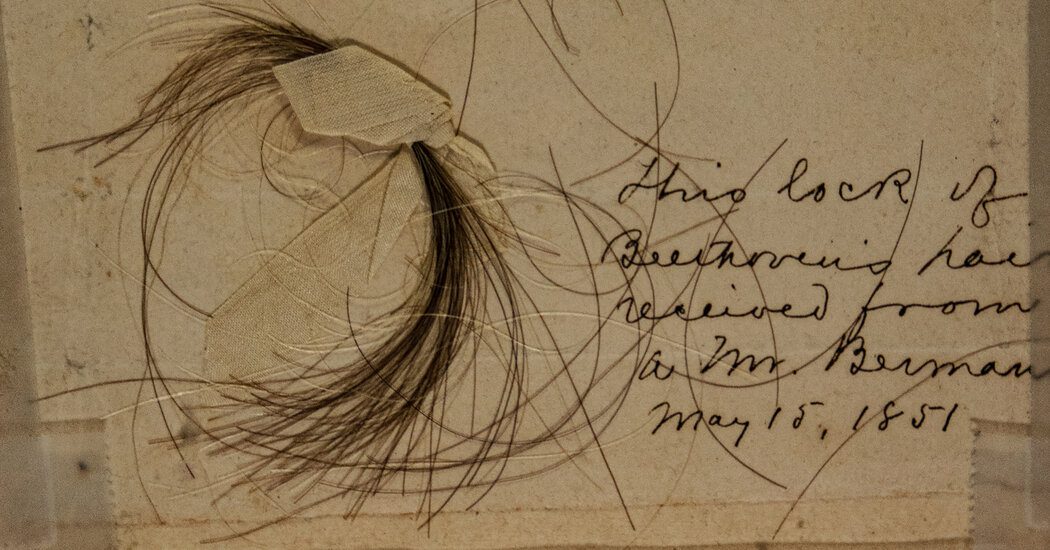[ad_1]
At 7 p.m. on May 7, 1824, Ludwig van Beethoven, then 53, strode onto the stage of the magnificent Theater am Kärntnertor in Vienna to help conduct the world premiere of his Ninth Symphony, the last he would ever complete.
That performance, whose 200th anniversary is on Tuesday, was unforgettable in many ways. But it was marked by an incident at the start of the second movement that revealed to the audience of about 1,800 people how deaf the revered composer had become.
Ted Albrecht, a professor emeritus of musicology at Kent State University in Ohio and author of a recent book on the Ninth Symphony, described the scene.
The movement began with loud kettledrums, and the crowd cheered wildly.
But Beethoven was oblivious to the applause and his music. He stood with his back to the audience, beating time. At that moment, a soloist grasped his sleeve and turned him around to see the raucous adulation he could not hear.
It was one more humiliation for a composer who had been mortified by his deafness since he had begun to lose his hearing in his twenties.
But why had he gone deaf? And why was he plagued by unrelenting abdominal cramps, flatulence and diarrhea?
A cottage industry of fans and experts has debated various theories. Was it Paget’s disease of bone, which in the skull can affect hearing? Did irritable bowel syndrome cause his gastrointestinal problems? Or might he have had syphilis, pancreatitis, diabetes or renal papillary necrosis, a kidney disease?
After 200 years, a discovery of toxic substances in locks of the composer’s hair may finally solve the mystery.
This particular story began a few years ago, when researchers realized that DNA analysis had advanced enough to justify an examination of hair said to have been clipped from Beethoven’s head by anguished fans as he lay dying.
William Meredith, founding director of the Ira F. Brilliant Center for Beethoven Studies at San Jose State University began searching for locks at auctions and in museums. Eventually he and his colleagues ended up with five locks that were confirmed by a DNA analysis to have come from the composer’s head.
Kevin Brown, an Australian businessman with a passion for Beethoven, owned three of the locks and wanted to honor Beethoven’s request in 1802 that when he died doctors might attempt to figure out why he had been so ill. Mr. Brown sent two locks to a specialized lab at the Mayo Clinic that has the equipment and expertise to test for heavy metals.
The result, said Paul Jannetto, the lab director, was stunning. One of Beethoven’s locks had 258 micrograms of lead per gram of hair and the other had 380 micrograms.
A normal level in hair is less than 4 micrograms of lead per gram.
“It definitely shows Beethoven was exposed to high concentrations of lead,” Dr. Jannetto said.
“These are the highest values in hair I’ve ever seen,” he added. “We get samples from around the world and these values are an order of magnitude higher.”
Beethoven’s hair also had arsenic levels 13 times what is normal and mercury levels that were 4 times the normal amount. But the high amounts of lead, in particular, could have caused many of his ailments, Dr. Jannetto said.
The investigators, including Dr. Jannetto, Mr. Brown and Dr. Meredith, describe their findings in a letter published on Monday in the journal Clinical Chemistry.
The analysis updates a report from last year, when the same team said Beethoven did not have lead poisoning. Now with thorough testing they say that he had enough lead in his system to, at the very least, explain his deafness and illnesses.
David Eaton, a toxicologist and professor emeritus at the University of Washington who was not involved in the study, said that Beethoven’s gastrointestinal problems “are completely consistent with lead poisoning.” As for Beethoven’s deafness, he added, high doses of lead affect the nervous system, and could have destroyed his hearing.
“Whether the chronic dose was sufficient to kill him is hard to say,” Dr. Eaton added.
No one is suggesting the composer was deliberately poisoned. But, Jerome Nriagu, an expert on lead poisoning in history and a professor emeritus at the University of Michigan, said that lead had been used in wines and food in 19th-century Europe, as well as in medicines and ointments.
One likely source of Beethoven’s high levels of lead was cheap wine. Lead, in the form of lead acetate, also called “lead sugar,” has a sweet taste. In Beethoven’s time it was often added to poor quality wine to make it taste better.
Wine was also fermented in kettles soldered with lead, which would leach out as the wine aged, Dr. Nriagu said. And, he added, corks on wine bottles were presoaked in lead salt to improve the seal.
Beethoven drank copious amounts of wine, about a bottle a day, and later in his life even more, believing it was good for his health, and also, Dr. Meredith said, because he had become addicted to it. In the last few days before his death at age 56 in 1827, his friends gave him wine by the spoonful.
His secretary and biographer, Anton Schindler, described the deathbed scene: “This death struggle was terrible to behold, for his general constitution, especially his chest, was gigantic. He still drank some of your Rüdesheimer wine in spoonfuls until he passed away.”
As he lay on his deathbed, his publisher gave him a gift of 12 bottles of wine. By then Beethoven knew he could never drink them. He whispered his last recorded words: “Pity, pity — too late!”
For a composer, deafness had been perhaps the worst affliction.
At age 30, 26 years before his death, Beethoven wrote: “For almost 2 years I have ceased to attend any social functions, just because I find it impossible to say to people: I am deaf. If I had any other profession, I might be able to cope with my infirmity, but in my profession it is a terrible handicap. And if my enemies, of whom I have a fair number, were to hear about it, what would they say?”
When he was 32, Beethoven mourned that he could not hear a flute, or a shepherd singing, which, he wrote, “brought me almost to despair. A little more and I would have committed suicide — only Art held me back. Ah it seemed unthinkable to leave the world until I had brought forth all that I feel lies within me.”
Over the years, Beethoven consulted many doctors, trying treatment after treatment for his ailments and his deafness, but found no relief. At one point, he was using ointments and taking 75 medicines, many of which most likely contained lead.
In 1823, he wrote to an acquaintance, also deaf, about his own inability to hear, calling it a “grievous misfortune,” and noting: “doctors know little; one finally tires of them.”
His Ninth Symphony was most likely a way to reconcile his grief with his art.
Since he was a teenager, Beethoven had been enthralled by a poem, “Ode To Joy,” by Friedrich Schiller.
He set the poem to music in the Ninth, sung by soloists and a chorus — considered the first instance of singing in a symphony. It was the culmination of the symphony, depicting a search for joy.
The first movement is a depiction of despair, Beethoven wrote. The second movement, with its loud kettledrums, is an attempt to break through the despair. The third reveals a “tender” world where despair is set aside, Beethoven wrote. But setting aside despair was not enough, he concluded. Instead, “one must search for something that calls us to life.”
The finale, the fourth movement, was that calling. It was the Ode to Joy.
In the years since, Beethoven’s Ninth has deeply moved millions, even Helen Keller who “heard” it by pressing her hand against a radio:
As I listened, with darkness and melody, shadow and sound filling all the room, I could not help remembering that the great composer who poured forth such a flood of sweetness into the world was deaf like myself. I marvelled at the power of his quenchless spirit by which out of his pain he wrought such joy for others — and there I sat, feeling with my hand the magnificent symphony which broke like a sea upon the silent shores of his soul and mine.
Source link











